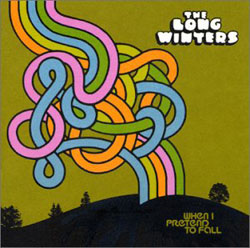THE LONG WINTERS
When I Pretend to Fall
(Barsuk)
Not everyone blessed with a 48-track imagination has a voice to match. Take John Roderick, the lead singer for local heroes the Long Winters. There’s no mistaking that he and they know their way around a studio, or that Roderick can write a tune and construct a ready-made. Just listen to the first 30 seconds of “Scared Straight”: Skippity-skip hi-hats add frisk to a straight-four rock plod as boogie piano and soaring post-soul horns evoke AM radio circa 1972 aural gummi-bear sweetness, studio-rock manna. Pretty great tune, toobut you’ll only notice it if you can get to the voice singing it. Roderick sounds something like a cross between Coldplay’s Chris Martin and Counting Crows’ Adam Duritz: a bit parched, undoubtedly cares a lot, potentially annoying as hell, not quite present enough to put his hooks as far over as you might prefer. “Scared Straight” and “Shapes” are so catchy they come close anyway. The annoying single “Cinnamon” doesn’t, though that may just be due to the fact that I don’t drive. Most of When I Pretend to Fall‘s Raspberries/Big Star moves seem built for in-car play; along with the Faces-aping “Prom Night at Hater High,” the band could have called the album That ’70s Show. MICHAELANGELO MATOS
The Long Winters play the Crocodile Cafe at 6 p.m. (all ages) and 9 p.m. (21 and over, ID only) Sat., July 19, with Clem Snide. $10 adv./$12.
ESSENTIAL LOGIC
Fanfare in the Garden: The Essential Logic Collection
(Kill Rock Stars)
First Liliput and now thisKill Rock Stars could just put out double-CD reissues of great out-of-print stuff from now on, and it would be difficult to complain. Not as track-by-track exhaustive as the Liliput collectionGreil Marcus’ liner notes acknowledge the absence of certain songsFanfare in the Garden collects the bulk of London post-punk legends Essential Logic’s output, starting with their late-’70s beginnings, when singer/saxophonist Lora Logic found herself unceremoniously removed from punk front-runners X-Ray Spex. Fanfare‘s two discs cover efforts through the early ’80s, as well as a slew of songs from Logic’s late-’90s career. The latter period keeps up the variety in a slightly quieter sense, with low-key breakbeats and the like, but the earlier songs are the true winners, making a virtue of to-the-point crispness and rollicking funlisten to “Wake Up,” which is at once reminiscent of Madness and the Fall, jaunty but with a sudden, slicing edge. Particularly early on, Logic’s singing voice captures a fine balance between aggression and controlshe never screams, she never simpers, but her swoop-heavy vocal style is commanding and completely individual. And her sax playing is as much the wild-card element in the music as Brian Eno’s keyboards were early on in Roxy Musicbut where Eno was a supporting player in that band, here Logic’s enjoyable honking leads the way. The slippery way both sax and voice slide through the mix of “Shabby Abbott,” or Logic’s matching and contrasting those two elements in “Moontown” (which moves slyly between hard-rock stomp, disco, and reggae), makes this both manna for newly christened no-wave hipsters and fine listening beyond category. NED RAGGETT
FREAKS
The Man Who Lived Underground
(Music for Freaks)
Dance music is imploding in England right nowsuperclubs closing, magazines folding, desperate journalists trying to light fires under any available tinder from punk-funk to neo-electro (still). The garish, upbeat, metronomic take on house that has characterized post-rave Britain is finally collapsing under the weight of mirrored sunglasses and Ibiza time-shares. Which is perfect for Freaks, who title one track on their third album “80’s Throwback.” But instead of electroclash’s skinny-tie irony, it’s nostalgia for the cocaine creepy-crawlies of ’80s Chicago that wonders who let the atomic dogs out. Like Green Velvet, Freaks revive the spiritif not the soundof early acid house. Imagine Basement Jaxx trax like “Yo-Yo” and “Get Me Off,” only thinned out and even more in thrall to mechanistic repetition, gibbering robot gremlins, j-j-jack your body commands, and P-Funky (non)sense. Plus beats reminiscent of, in no particular order, Ping-Pong, rock tumblers, ball bearings in a coffee can, and spray-paint rattle. Aside from the brilliantly moody ballad “Where Were You When the Lights Went Out,” these tracks might seem slight to the point of irrelevance on their own. But as a whole they’re like little windows opening onto weird sex, freaky dancing, and other Princely activities. Short (most tracks barely make the two-minute mark), dirty, weird, and deep like a K-hole, The Man Who Lived Underground is the best argument in a long time for the continuing existence of both the house album and house music itself. JESS HARVELL




